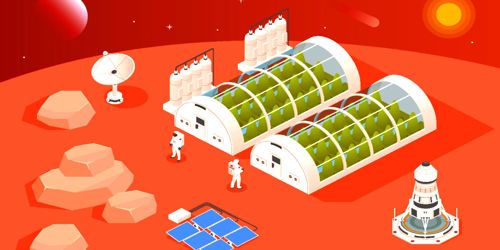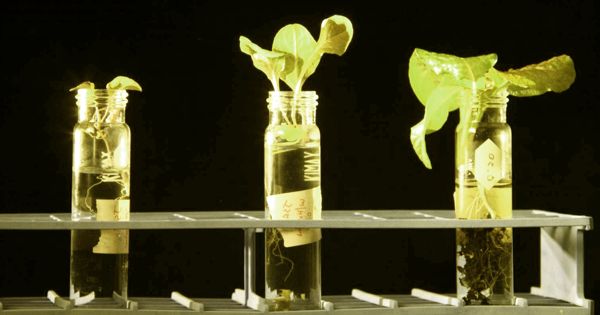It’s not easy to guess what we can or will not be able to do when we set foot on Mars. But as far as the chemistry performed in The Martian is concerned, Watney’s scientific method has been tested. Scientists also performed plant studies simulating Martian soil conditions using volcanic soil in Hawaii, known for its resemblance to Martian soil. These studies have demonstrated that plants can actually thrive in these soils.
A little more than a year after the opening of the Buzz Aldrin Space Institute at Florida Tech with an underlying mission to bring people to Mars, this horticultural research will aim to solve one of the most important problems awaiting the first Martian settlers: how to cultivate food in a cold and polluted environment.
Scientists have conducted plant experiments simulating Martian conditions using volcanic soil in Hawaii, which is known for its similarity to Martian soil. These experiments found that plants can actually grow in these soils.
There are also no lush, green rows of veggies or vines covered in fruit: the garden is in its infancy. Drew Palmer, Assistant Professor of Biological Sciences, Brooke Wheeler, Assistant Professor at the College of Aeronautics, and majors in astrobiology at the Department of Physics and Space Sciences, are developing lavish lettuce (a type of red roman) in various settings – earth dirt, similar Martian surface content known as regolith simulant, and regolith simulant with a nutrient add-on. “We have to get the regolith right or anything we do won’t be valid,” said Andy Aldrin, director of the Buzz Aldrin Space Institute.
Mars’ atmosphere is mainly carbon dioxide, and plants need this gas just as much as humans need oxygen to breathe. The new Mars regolith simulant is not fine. Before the first Mars dirt sample returns to Earth, which may be on a mission expected to be at least 15 years from now, Florida Tech researchers will spend the next year attempting to construct a reliable regolith analog by adding chemical sensing data from the Mars rovers.

The biggest shortfall is the rocky, meteorite-prone surface of Mars – its crushed rock with a high iron content and chemical perchlorates – and its high doses of UV radiation. Kusuma plans to circulate this topic by growing plants several meters underground in earth-like environments.
Eventually, it may be possible to cultivate different plants in the Martian soil by applying fertilizer and eliminating perchlorates. Florida Tech scientists are working with NASA scientists who have knowledge in growing plants at the International Space Station to help discover ways to make Martian farming a possibility.
With costs reaching $1 billion per human per year and logistics issues about shipping enough food from Earth to Mars, increasing food on the planet itself is a requirement, Aldrin claims. “You can’t sustain civilization if you have to ship it all,” he said.
Florida Tech’s presence helps NASA to focus on other challenges related to Mars. “With our academic partners working on planetary surface food production, NASA is able to focus on the near-term technologies and systems needed to bring our crews to the Red Planet,” said Trent Smith, project manager at NASA’s Kennedy Space Center.
Ralph Fritsche, Senior Project Manager for Food Development at KSC, said, “It’s terrific to have academic institutions plant both feet into the long-term human exploration of Mars—experiments to determine how to grow crops off-earth.”
Palmer and Wheeler plan to introduce their Martian garden to other influences, such as radiation damage to seeds as they migrate from Earth to Mars, as well as root growth in lesser gravity, and how much water they would require, and where that water would come from.
Even if the habitation of the Red Planet is still decades away, exploration might have an effect on Earth. “The ultimate test of sustainability is to think about how to live on Mars,” says Daniel Batcheldor, Professor of Physics and Space Science at Florida Tech and Team Leader at the Buzz Aldrin Space Institute.
“Learning to grow plants in an inhospitable environment like Mars could help us maximize food production and minimize the use of valuable resources such as water and fertilizer back here on Earth.”
Any conditions will make it impossible for plants to thrive on Mars. Mars’ intense cold conditions, for example, make it impossible to sustain. Sunlight and radiation touching this planet is even smaller than the Earth receives. You will cultivate plants on Mars in the right conditions. Earth’s atmosphere is 78 percent nitrogen and 0.04 percent carbon dioxide. Mars, on the other hand, has more than 95 percent carbon dioxide and 2.6 percent nitrogen. Mars is 100 times less nitrogen than Earth. Nitrogen is important for plant growth. This is because Mars is some 50 million miles distant from the sun. The Martian atmosphere is not as dense as the Earth’s atmosphere, which keeps our world warm.















